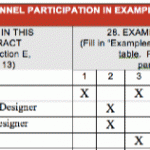
Open up a drawer and throw them in. Everybody knows that’s not what you should be doing with business cards you receive. Yet, I’ve done it. And I’m not alone.
The more events you go to, the more cards you’ll collect. And having to deal with all those business cards can seem like an albatross around your neck.
You know there is something you should be doing with those cards. But at the same time, you’ve got a million deadlines breathing down your neck. And everybody at the office has made it their life’s work to distract you from the things you really want to get done.
So, those cards become just one more thing you’ve got to deal with “eventually.”
But what if you had a headache-free process for dealing with all those business cards? And what if it only took five minutes of your precious, constantly running thin, time?
Well, that’s why you’re reading this, so let’s get to it.
What To Do With Business Cards You Receive
In a moment, I’m going to regale you with my simple 5-Minute Business Card Solution. Not only that, I’m going to give you word-for-word followup email templates you can use.
But before I get into that, let me lay waste to some time-honored business etiquette.
You Have Permission To Throw My Business Card Out
Only a total jerk would throw out someone’s business card. Give yourself permission to be that jerk.
Listen, we’ve been taught that every contact you make is valuable. And that’s true, the first guy who ever gave me a business card also got me my job and helped me land a wife.
And that fateful card he gave me…it’s in the trash.
Each year, 15% of the people you meet will switch jobs. And that problem compounds. Let’s say you enter 500 contacts into a CRM or address book. After just three years, nearly half of those entries could have wrong contact info.
The accuracy of your contact database is constantly degrading. The more “garbage” you put in, the more garbage you’ll get out.
You don’t have to keep information on everyone you meet. You don’t have to enter everyone into your system, Rolodex, or whatever you use.
In fact, many of those systems were built assuming you’d only enter leads in them.
If I give you my card at an event, you have permission to throw it out! Just wait until I’ve turned around. Throw it in a trash can. Then light the trash can on fire for good measure. 🙂
Always Label People
Every person you meet is a unique butterfly. But we don’t have time for that so we’ll slap a label on them, categorize their existence, and throw them in the appropriate bucket.
Every system imaginable has a way to categorize or label contacts. It could mean separate Rolodexes, multiple binders, labels in Outlook, or categories in your CRM.
Regardless, you’ll put everybody you meet in a specific category. Here are the ones I use:
- Potential Client/Lead
- Current Client
- Past Client
- Potential Teaming Partner
- Teaming Partner
- Influencer
- Vendor
- Friend
- Contact
Trust me, you’ll see the value in categorizing contacts once you have met a couple hundred people.
The 5-Minute Business Card Solution
But let’s say you get a business card you feel you should keep. What should you do with it?
Just follow these four simple steps.
Step One: Write On The Back Of Each Card
Whenever you’re at an event, you want to have a pen on you. Keep one handy in your purse or wallet. I’ve been using a special wallet for many years because it has a collapsible pen in it.
When someone gives you a card, right then and there, just ask if it’s Ok to write on the back of it. And you can jot down notes then and there. They won’t be annoyed, they’ll be impressed.
If you’re just starting the conversation, wait until you walk away to jot down your notes.
And if you forgot your pen or their company is stupid enough to have a black background on their card, just write down notes in an email to yourself on your phone.
I write down these things on the back of each card:
- Category
- Interests they might have mentioned to me (like fishing or music or even an industry association they’re involved in)
- A note regarding where you met them and who they are.
- Next action I need to take (See this article about ending conversations
It is critical that you do this at the event. As soon as you walk out that door, your mind will fill up with other thoughts. You’ll forget every conversation you had or why you even attended the event in the first place.
Step Two: Have Someone Else Put Them In A Trusted System
Now you’ve got a pocket full of business cards with notes on the back. You’ve just got to enter all this data into a system. Right? Wrong!
You’ve got to find someone or something to do it for you. That may mean begging an admin, firing up a card scanning app, or forcing your kids into child labor.
Find someone or something you can trust to enter the data into a system (even if that system is binders).
Yes, they’ll make data entry mistakes at first. Just spot check their work and make adjustments until you are comfortable that they won’t screw up.
Step Three: Send Customized Followups To The Top Two Or Three
If you’ve gone to the right event, there are likely to be two or three people you know you absolutely have to follow up with.
The best example of this would be a potential client that has agreed to meet with you. Check out my Guide to Getting Meetings with Busy People for word-for-word scripts on how to arrange those meetings.
Nobody likes a long follow up email. So, keep it fairly short and to the point.
Step Four: Send Boilerplate Followups To Everyone Else
After you sent custom followups with the two or three critically important people you’ve met, everyone else falls into two buckets:
- People you want to continue a relationship with
- Everyone else
For the ultra-lazy like me, you can speed up this process by using software like TextExpander or Phrase Express.
Here’s the exact script I use when sending out boilerplate followups:
—
Subject: Great talking to you at [EVENT NAME]
Hi [FIRST NAME],
It was great seeing you at the [EVENT NAME]. I enjoyed our conversation about [TOPIC].
As mentioned, [NEXT ACTION].
P.S. I have attached my vcard, which contains my contact information. You should be able to click on it and add me to your contacts.
—
Note that while that script has some variables, you’ve recorded each one on the back of that person’s business card.
I’ve been using the 5-Minute Business Card Solution for years. It allows me to do what 95% of people don’t…follow up with people after I meet them at an event.
Now It’s Your Turn
Do you have any tricks or processes you use when dealing with the business cards you collect?
Share with us in the comments.





I always schedule time the day after an event to take action on the contacts I make at a convention or workshop. That’s my established habit, and it works well. I’ve learned that if I don’t take immediate action the next day, other work will creep in and ultimately consume my good intentions.
Great habit. To be clear I think you are saying you put an rvwnt on your calendar and block out time for follow up.
Nice, Matt! I just got back from a conference with a bundle of cards, and I’ve already reached out to “connect” with everyone on LinkedIn. As much as everyone loves to make fun of LI, it has the advantage of staying up to date when folks move jobs, etc. Plus, my blog posts to LI automatically, so by connecting, those contacts get my blog posts in their feed. (And then, yes, I throw out the cards!)
Hey Melissa,
Good point about LinkedIn. I still read your posts from time to time.
First I reach out to the person on LinkedIn, then I throw the card in the recycle bin beside my desk. That’s better than throwing them in the trash.